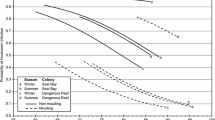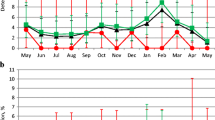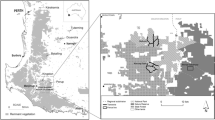Abstract
A placebo-controlled study was used to investigate the effectiveness of ivermectin to treat hookworm (Uncinaria sanguinis) and lice (Antarctophthirus microchir) infections in free-ranging Australian sea lion (Neophoca cinerea) pups and to test the hypotheses that these parasitic infections cause anaemia, systemic inflammatory responses, and reduced growth, and contribute towards decreased pup survival. Ivermectin was identified as an effective and safe anthelmintic in this species. Pups administered ivermectin had significantly higher erythrocyte counts and significantly lower eosinophil counts compared to controls at 1–2 months post-treatment, confirming that U. sanguinis and/or A. microchir are causatively associated with disease and demonstrating the positive effect of ivermectin treatment on clinical health parameters. Higher growth rates were not seen in ivermectin-treated pups and, unexpectedly, relatively older pups treated with ivermectin demonstrated significantly reduced growth rates when compared to matched saline-control pups. Differences in survival were not identified between treatment groups; however, this was attributed to the unexpectedly low mortality rate of recruited pups, likely due to the unintended recruitment bias towards pups >1–2 months of age for which mortality due to hookworm infection is less likely. This finding highlights the logistical and practical challenges associated with treating pups of this species shortly after birth at a remote colony. This study informs the assessment of the use of anthelmintics as a tool for the conservation management of free-ranging wildlife and outlines essential steps to further the development of strategies to ensure the effective conservation of the Australian sea lion and its parasitic fauna.






Similar content being viewed by others
References
Acevedo-Whitehouse K, Petetti L, Duignan P, Castinel A (2009) Hookworm infection, anaemia and genetic variability of the New Zealand sea lion. Proc R Soc B 276:3523–3529. doi:10.1098/rspb.2009.1001
Barnes J, Higgins DP, Gray R (2008) Pinnipeds. In: Vogelnest L, Woods R (eds) Medicine of Australian mammals. CSIRO, Melbourne, pp 541–589
Beekman GK (1984) Clinical use of ivermectin against the hookworm (Uncinaria lucasi) of northern fur seal pups (Callorhinus ursinus). Internat Assoc Aqua An Med (IAAAM) Proceed 15:50
Bordes F, Morand S (2011) The impact of multiple infections on wild animal hosts: a review. Infect Ecol Epidemiol. doi:10.3402/iee.v1i0.7346
Castinel A (2007) Causes of neonatal mortality in the New Zealand sea lion (Phocarctos Hookeri). PhD dissertation, Massey University
Castinel A, Duignan PJ, Lyons ET, Pomroy WE, Gibbs NJ, Lopez-Villalobos N, Chilvers BL, Wilkinson IS (2007) Epidemiology of hookworm (Uncinaria spp.) infection in New Zealand (Hooker’s) sea lion (Phocarctos hookeri) pups on Enderby Island, Auckland Islands (New Zealand) during the breeding seasons from 1999/2000 to 2004/2005. Parasitol Res 101:53–62. doi:10.1007/s00436-006-0453-z
Chilvers BL, Duignan PJ, Robertson BC, Castinel A, Wilkinson IS (2009) Effects of hookworms (Uncinaria sp.) on the early growth and survival of New Zealand sea lion (Phocarctos hookeri) pups. Polar Biol 32:295–302. doi:10.1007/s00300-008-0559-0
Clark P, Boardman WS, Duignan PJ (2002) Cytology of haematological cells of otariid seals indigenous to Australasian waters. Aust Vet J 80:161–164. doi:10.1111/j.1751-0813.2002.tb11383.x
Dailey MD (2001) Parasitic Diseases. In: Dierauf LA, Gulland FMD (eds) CRC handbook of marine mammal medicine, 2nd edn. CRC, Florida, pp 357–382
DeLong RL, Orr AJ, Jenkinson RS, Lyons ET (2009) Treatment of northern fur seal (Callorhinus ursinus) pups with ivermectin reduces hookworm-induced mortality. Mar Mamm Sci 25:944–948. doi:10.1111/j.1748-7692.2008.00274.x
Forrester JE, Bailar JC III, Esrey SA, José MV, Castillejos BT, Ocampo G (1998) Randomised trial of albendazole and pyrantel in symptomless trichuriasis in children. Lancet 352:1103–1108. doi:10.1016/s0140-6736(97)08325-6
Goldsworthy SD, Gales NJ (2008) Neophoca cinerea. In: IUCN red list of threatened species. Version 2013.2. http://www.iucnredlist.org/details/14549. Accessed 1 May 2014
Goldsworthy SD, McKenzie J, Shaughnessy PD, McIntosh RR, Page B, Campbell RA (2009) An update of the report: understanding the impediments to the growth of Australian sea lion populations. SARDI Publication Number F2008/00847-1. SARDI Research Report series No. 356, Adelaide, Australia
Goldsworthy SD, Page B, Lowther AD, Shaughnessy PD (2012) Maintaining the monitoring of pup production at key Australian sea lion colonies in South Australia (2010/11). SARDI Publication Number F2010/000665-2. SARDI Research Report series No. 601, Adelaide, Australia
Goldsworthy SD, Kennedy CW, Shaughnessy PD, Mackay AI (2014) Monitoring of Seal Bay and other pinniped populations on Kangaroo Island: 2012–2015. SARDI Publication No. F2014/000332-1. SARDI Research Report Series No. 782, Adelaide, Australia
Gómez A, Nichols E (2013) Neglected wild life: parasitic biodiversity as a conservation target. Int J Parasitol Parasites Wildl 2:222–227. doi:10.1016/j.ijppaw.2013.07.002
Haynes BT, Marcus AD, Higgins DP, Gongora J, Gray R, Šlapeta J (2014) Unexpected absence of genetic separation of a highly diverse population of hookworms from geographically isolated hosts. Infect Genet Evol 28:192–200. doi:10.1016/j.meegid.2014.09.022
Higgins LV (1993) The nonannual, nonseasonal breeding cycle of the Australian sea lion, Neophoca cinerea. J Mammal 74:270–274. doi:10.2307/1382381
Higgins LV, Gass L (1993) Birth to weaning: parturition, duration of lactation, and attendance cycles of Australian sea lions (Neophoca cinerea). Can J Zool 71:2047–2055. doi:10.1139/z93-290
Higgins LV, Tedman RA (1990) Effect of attacks by male Australian sea lions, Neophoca cinerea, on mortality of pups. J Mammal 71:617–619. doi:10.2307/1381802
Hotez P, Brooker S, Bethony J, Bottazzi M, Loukas A, Xiao S (2004) Hookworm infection. N Engl J Med 351:799–807
Irvine RJ (2006) Parasites and the dynamics of wild mammal populations. Anim Sci 82:775–781. doi:10.1017/ASC2006106
Krämer F, Epe C, Mencke N (2009) Investigations into the prevention of neonatal Ancylostoma caninum infections in puppies by application of imidacloprid 10 % plus moxidectin 2.5 % topical solution to the pregnant dog. Zoonoses Public Health 56:34–40. doi:10.1111/j.1863-2378.2008.01181.x
Leonardi MS, Crespo EA, Raga JA, Aznar FJ (2013) Lousy mums: patterns of vertical transmission of an amphibious louse. Parasitol Res 112:3315–3323. doi:10.1007/s00436-013-3511-3
Lowther AD, Goldsworthy SD (2011) Maternal strategies of the Australian sea lion (Neophoca cinerea) at Dangerous Reef, South Australia. Aust J Zool 59:54–62. doi:10.1071/ZO11025
Lyons ET, Delong RL, Spraker TR, Melin SR, Laake JL, Tolliver SC (2005) Seasonal prevalence and intensity of hookworms (Uncinaria spp.) in California sea lion (Zalophus californianus) pups born in 2002 on San Miguel Island, California. Parasitol Res 96:127–132. doi:10.1007/s00436-005-1335-5
Marcus AD, Higgins DP, Gray R (2014a) Epidemiology of hookworm (Uncinaria sanguinis) infection in free-ranging Australian sea lion (Neophoca cinerea) pups. Parasitol Res 113:3341–3353. doi:10.1007/s00436-014-3997-3
Marcus AD, Higgins DP, Šlapeta J, Gray R (2014b) Uncinaria sanguinis sp. n. (Nematoda: Ancylostomatidae) from the endangered Australian sea lion, Neophoca cinerea (Carnivora: Otariidae). Folia Parasitol 61:255–265. doi:10.14411/fp.2014.037
Marcus AD, Higgins DP, Gray R (2015) Health assessment of free-ranging endangered Australian sea lion (Neophoca cinerea) pups: effect of haematophagous parasites on haematological parameters. Comp Biochem Physiol A Mol Integr Physiol 184:132–143. doi:10.1016/j.cbpa.2015.02.017
McIntosh RR, Kennedy CW (2013) Morphology, sex ratio and cause of death in Australian sea lion (Neophoca cinerea) pups. Aust Mamm 35:93–100. doi:10.1071/AM12037
McIntosh RR, Murray MD (2007) Louse infestations of the Australian sea lion Neophoca cinerea. Aust Mamm 29:103–106. doi:10.1071/AM07014
McIntosh RR, Shaughnessy PD, Goldsworthy SD (2006) Mark-recapture estimates of pup production for the Australian sea lion (Neophoca cinerea) at Seal Bay Conservation Park, South Australia. In: Trites AW, Atkinson SK, DeMaster DP, Fritz LW, Gelatt TS, Rea LD, Wynne KM (eds) Sea lions of the world. Alaska Sea Grant College Program, Fairbanks, pp 353–367
McIntosh RR, Goldsworthy SD, Shaughnessy PD, Kennedy CW, Burch P (2012) Estimating pup production in a mammal with an extended and aseasonal breeding season, the Australian sea lion (Neophoca cinerea). Wildl Res 39:137–148. doi:10.1071/WR10222
McIntosh RR, Arthur AD, Dennis TE, Berris M, Goldsworthy SD, Shaughnessy PD, Teixeira CEP (2013) Survival estimates for the Australian sea lion: negative correlation of sea surface temperature with cohort survival to weaning. Mar Mamm Sci 29:84–108. doi:10.1111/j.1748-7692.2011.00558.x
Needham DJ, Cargill CF, Sheriff D (1980) Haematology of the Australian sea lion, Neophoca cinerea. J Wildl Dis 16:103–107. doi:10.7589/0090-3558-16.1.103
Sajid MS, Iqbal Z, Muhammad G, Iqbal MU (2006) Immunomodulatory effect of various anti-parasitics: a review. Parasitology 132:301–313. doi:10.1017/S0031182005009108
Schmertmann L (2010) Investigating aspects of health and disease in Australian sea lion, Neophoca cinerea, pups: haematology and protein analysis. Honours dissertation, The University of Sydney
Shaughnessy PD, Goldsworthy SD (2014) Long-nosed fur seal: a new vernacular name for the fur seal, Arctocephalus forsteri, in Australia. Mar Mamm Sci. doi:10.1111/mms.12203
Shaughnessy PD, Goldsworthy SD, Hamer DJ, Page B, McIntosh RR (2011) Australian sea lions Neophoca cinerea at colonies in South Australia: distribution and abundance, 2004 to 2008. Endanger Species Res 13:87–98. doi:10.3354/esr00317
Shaughnessy PD, Goldsworthy SD, Burch P, Dennis TE (2013) Pup numbers of the Australian sea lion (Neophoca cinerea) at The Pages Islands, South Australia, over two decades. Aust J Zool:112–118. doi:10.1071/ZO13015
Shaughnessy PD, Goldsworthy SD, Mackay AI (2014) Status and trends in abundance of New Zealand fur seal populations in South Australia. SARDI Publication No. F2014/000338-1. SARDI Research Report Series No. 781, Adelaide, Australia
Simpson K (2014) Acute phase proteins and maternally and actively acquired IgG in Australian sea lion (Neophoca cinerea) pups with hookworm (Uncinaria sanguinis) infection. Honours dissertation, The University of Sydney
Smith KF, Acevedo-Whitehouse K, Pedersen AB (2009) The role of infectious diseases in biological conservation. Anim Conserv 12:1–12. doi:10.1111/j.1469-1795.2008.00228.x
Speare R, Canyon DV, Melrose W (2006) Quantification of blood intake of the head louse: Pediculus humanus capitis. Int J Dermatol 45:543–546. doi:10.1111/j.1365-4632.2005.02520.x
Stringer AP, Linklater W (2014) Everything in moderation: principles of parasite control for wildlife conservation. Bioscience 64:932–937. doi:10.1093/biosci/biu135
Tee MH, Lee YY, Majid NA, Noori NM, Raj SM (2013) Growth reduction among primary school-children with light trichuriasis in Malaysia treated with albendazole. Southeast Asian J Trop Med Public Health 44:19–24
Telfer S, Bennett M, Bown K, Carslake D, Cavanagh R, Hazel S, Jones T, Begon M (2005) Infection with cowpox virus decreases female maturation rates in wild populations of woodland rodents. Oikos 109:317–322. doi:10.1111/j.0030-1299.2005.13734.x
Thompson RCA, Lymbery AJ, Smith A (2010) Parasites, emerging disease and wildlife conservation. Int J Parasitol 40:1163–1170. doi:10.1016/j.ijpara.2010.04.009
Van Oers K, Heg D, Le Drean Quenec'hdu S (2002) Anthelminthic treatment negatively affects chick survival in the Eurasian Oystercatcher Haematopus ostralegus. Ibis 144:509–517. doi:10.1046/j.1474-919X.2002.00078.x
Vercruysse J, Salomez A, Ulloa A, Osterhaus A, Kuiken T, Alvinerie M (2003) Efficacy of ivermectin and moxidectin against Otostrongylus circumlitus and Parafilaroides gymnurus in harbour seals (Phoca vitulina). Vet Rec 152:130–134. doi:10.1136/vr.152.5.130
Woon S (2012) Transdermal penetration of avermectins in Australian sea lion (Neophoca cinerea) pups. Honours dissertation, The University of Sydney
Yazdanbakhsh M, Kremsner PG, van Ree R (2002) Allergy, parasites, and the hygiene hypothesis. Science 296:490–494. doi:10.1126/science.296.5567.490
Acknowledgements
We thank Tony Jones and Adam Kemp of Protec Marine, Port Lincoln, South Australia for providing transport and logistical support for field work at Dangerous Reef. We also thank Navneet Dhand of The University of Sydney for statistical advice regarding study design; Christine Gotsis and George Tsoukalas of the Veterinary Pathology Diagnostic Service, Faculty of Veterinary Science, The University of Sydney for laboratory assistance; and volunteers and colleagues for field assistance: Simon Goldsworthy, Andrew Lowther, Paul Rogers, Laura Schmertmann, Adrian Simon, Michael Terkildsen, Mark Whelan, and Peter White. This work was supported by the Australian Marine Mammal Centre, Department of the Environment, Australian Government (grant number 09/17). All samples were collected under Government of South Australia Department of Environment, Water and Natural Resources Wildlife Ethics Committee approvals (3–2008 and 3–2011) and Scientific Research Permits (A25088/4–8).
Conflict of interest
The authors declare that they have no conflict of interest.
Author information
Authors and Affiliations
Corresponding author
Rights and permissions
About this article
Cite this article
Marcus, A.D., Higgins, D.P. & Gray, R. Ivermectin treatment of free-ranging endangered Australian sea lion (Neophoca cinerea) pups: effect on hookworm and lice infection status, haematological parameters, growth, and survival. Parasitol Res 114, 2743–2755 (2015). https://doi.org/10.1007/s00436-015-4481-4
Received:
Accepted:
Published:
Issue Date:
DOI: https://doi.org/10.1007/s00436-015-4481-4




